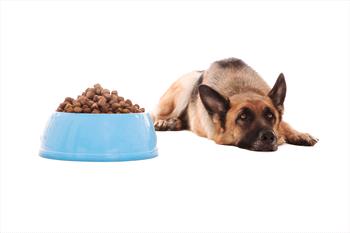If your dog has always been a picky eater, there is likely no need for concern. The main thing to consider is if his attitude toward food has changed.
inappetent dog next to food bowl

Photo courtesy of Deposit Photos
If your finicky eater maintains a healthy weight, if he is alert/perky, and has a shiny coat, that is one thing. If he was a good eater, but has suddenly stopped, that’s different. That could mean something has changed with his regular food. (Is it spoiled? Does it smell odd? Does it look different?) Or it could mean that something is wrong with him, physically or emotionally. If he has lost weight, is sluggish, has developed gastrointestinal problems (nausea, vomiting, diarrhea), tooth problems, or mouth sores, then you should have your veterinarian check him out. Even joint pain can make your dog reluctant to walk to his bowl to eat.
Some dogs seem to live to eat - dinnertime is an important part of their day - and some just eat to live. This attitude can vary by breed and by the way they were taught to think about food.
If your dog grew up with you offering multiple kinds of food, that may have trained him to hold out for something better, just like children will hold out for ice cream, instead of Brussel sprouts. If you’re constantly coaxing your dog to eat, then your dog has trained you to keep offering tastier and tastier items.
You may think your dog wants or needs a variety of foods, but he doesn’t. Your dog can eat the same food every day as long as it’s nutritionally correct.
Sometimes, the picky eater’s problem is that he doesn’t like the brand of food you’re giving him, or that he prefers a different texture (canned food instead of dry or vice versa).
The more you keep offering table scraps, treats, gravy, cookies, etc., the more you’re risking creating a picky eater – and one that will become obese.
So if your dog is picky because he was “trained” to be, how can you correct this? You can teach him to understand that he doesn’t have options.
- Put out his food for 30 minutes. What he doesn’t eat, pick up and take away.
- At the next scheduled feeding time, put out his food for 30 minutes. Pick up and take away anything he hasn’t eaten.
- Now, in a day or so, he may start asking (begging) for treats. Do not give in. He’s not starving. If he were hungry, he’d eat his dog food. Make sure everyone in the family understands why they should present a united front in this project. You do not want one person “cheating” and giving table scraps. That will prevent your dog from becoming a good eater, and it will encourage his begging behavior. Besides, table scraps can cause pancreatitis, vomiting, diarrhea, etc. And some human foods are toxic to dogs, so always stick with a well-balanced canine diet.
- Your dog will likely be disappointed that he isn’t getting his way. But that’s why you’re the boss. It’s up to you to set the standards and it’s his job to follow them. It’s just like making sure your children don’t eat candy as their complete diet. You’re doing the same thing for your pet. You’re keeping him healthy and at a proper weight so he’ll live a longer life with you.
- Do not distract him during his dinner time, or let other dogs pester him while he’s eating. Give him attention when he’s not eating.
- Stick to a schedule. Consistency is important. If you are feeding a puppy, then he needs to eat two to three times each day, or as recommended by your vet. As your puppy matures, increase the volume of food as you decrease the frequency of feedings. An adult dog should be fed once or twice daily without leaving the food out for more than 30 minutes. Use a measuring cup to make sure you’re feeding the correct amount.
- Sometimes, just taking your dog for a nice walk before meal time can improve his appetite. He’s getting attention from you, and he’s getting his body ready for dinnertime.
- What about treats for training? Food isn’t the only way to reward your dog. Dogs love getting attention – praise, petting, etc. If you do think you need food treats, limit the number to only a few a week, and after successfully performing a “trick.” Intermittent rewards work better than a reward after every success, too. And track the treats, to make sure you and your family members aren’t going overboard. It’s easy to forget just how many treats have been given out over a week.
Sometimes, as part of treating your pet’s health issues, you may have to change your dog’s diet. The trick is to do it gradually.
- Start by combining some of the new food with the old food. Over a few days, gradually increase the amount of new food as you reduce the amount of old food. This will help get your dog accustomed to the new food. Switching foods suddenly may make some dogs stop eating and may make them try to manipulate you; it can also cause upset stomachs.
- If you’re switching from wet to dry food, try mixing in a small amount of warm water with the dry food to get somea of the same consistency your dog was used to.
With some effort and time, which may be longer than you envision, you can help your dog if the reason he's not eating well is purely behavior. Visit your veterinarian to see if there is any medical reason that can be treated so that his normal appetite will return.